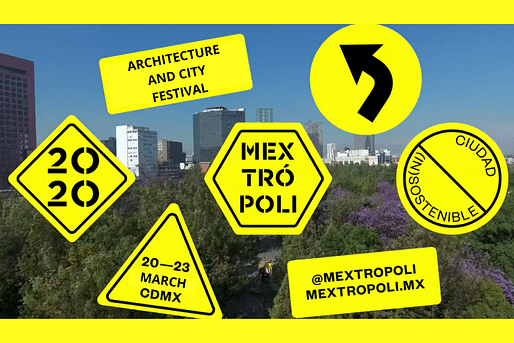

This post is brought to you by Arquine
Update: The festival has been rescheduled to Sept 5th - Sept 7th 2020
The seventh edition of the MEXTRÓPOLI Festival of Architecture and City will address an unavoidable issue on the urban planning and architecture agenda: the climate crisis.
If a few years ago we asked ourselves in MEXTRÓPOLI about the possibilities of the future as a capacity of political imagination, today it seems that the question is reduced to the possibility of any future. It seems alarmist. Maybe it is. But we must not forget that behind the "I want you to panic" approach of Greta Thurnberg, there is still a call of hope: I want you to act.
Densification, water, and population are factors that are also important when thinking about the present and future of our cities, especially under the risky context in regards to the climatic conditions of the planet. For this reason, the MEXTRÓPOLI Architecture and City Festival will reflect on a fundamental theme that will allow us to build new responsibilities towards the future of cities; this without leaving aside the festive spirit that invites the citizen to appropriate their spaces. The seventh edition of this architecture and city encounter will be an intense and enriching day for all those interested in architecture, urban planning and culture in general.
For its 2020 edition, MEXTRÓPOLI will have the presence of:
Architect Wang Shu, awarded the Pritzker Prize in 2012, and his associate, architect Lu Wenyu. The study builds a critical vision towards the architecture profession, with regards to the demolition and destruction of large urban areas. At the Venice Architecture Biennale in 2006, they presented the piece Tiled Garden, an installation made of 66,000 recycled tiles that were rescued from demolition sites. With this gesture, the studio called Amateur Architecture Studio, expressed their views on the demolitions and reuse of building materials.
Architect, urban planner, theoretician and pedagogue Moshe Safdie. Of Israeli-Canadian origin, Safdie has explored the essential principles of socially responsible design with a different visual language. Safdie graduated from McGill University. In 1964 he established his own firm to perform Habitat’67, an adaptation of his undergraduate thesis and a turning point in modern architecture. The project promoted the design and implementation of three-dimensional prefabricated housing units.
Mexican architect Frida Escobedo, founder and director of her own architecture and design studio based in Mexico City. The work carried out in Frida Escobedo's studio covers art installations and furniture design to residential and public buildings. Some of his ephemeral interventions are the Pavilion Eco 2010 or the Serpentine Pavillion 2018, in addition to La Tallera in Cuernavaca, one of the museums with one of the most innovative architectures of recent years.
Manuela Carmena was mayor of Madrid in the period between 2015 and 2019. In addition, she was a member of the General Council of the Judiciary between 1996 and 2001. During her administration, an environmental and pedestrianization initiative was launched that privileged the presence of the citizen over that of the car.
Every year, the MEXTRÓPOLI Architecture and City Festival will also mount pavilions in the Alameda Central that seek to interact with the pedestrian realm, in addition to the MEXTRÓPOLI 2020 Pavilion, winner of the Arquine Contest No. 22 will be shown. This time, the piece is projected by a London team made up of Sabrina Morreale, Lorenzo Perri (from Lemonot Studio) and Federico Fauli.
Three days to think and celebrate the city: MEXTRÓPOLI 2020 - Live the extraordinary city!
Stay up to date with the festival and follow them on TWITTER, FACEBOOK, INSTAGRAM
*As an official media partner, stay tuned for Archinect's exclusive coverage of the event!
No Comments
Block this user
Are you sure you want to block this user and hide all related comments throughout the site?
Archinect
This is your first comment on Archinect. Your comment will be visible once approved.